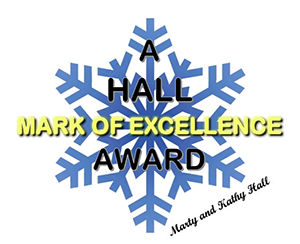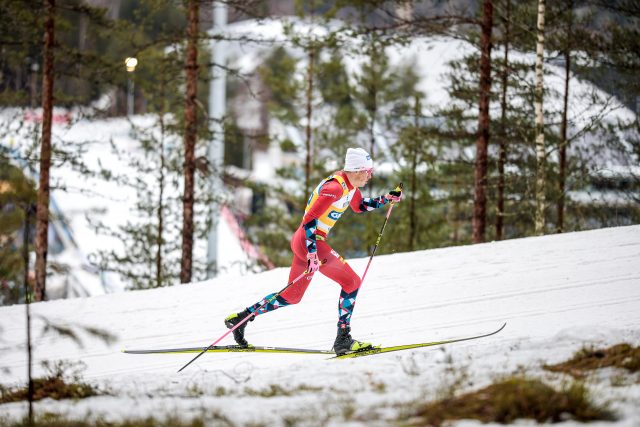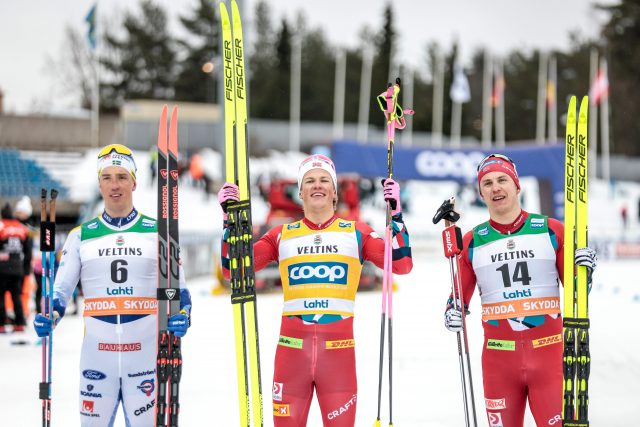 This World Cup coverage is made possible through the generous support of Marty and Kathy Hall and A Hall Mark of Excellence Award. To learn more about A Hall Mark of Excellence Award, or to learn how you can support FasterSkier’s coverage, please contact info@fasterskier.com.
This World Cup coverage is made possible through the generous support of Marty and Kathy Hall and A Hall Mark of Excellence Award. To learn more about A Hall Mark of Excellence Award, or to learn how you can support FasterSkier’s coverage, please contact info@fasterskier.com.

By this time in his storied and much-decorated career, Johannes Hoesflot Klaebo (NOR) definitely knows his way around a bottle of champagne. Given enough time on World Cup podiums (as Klaebo has had), an athlete will come to master the sharp-ended wire frame, the peelable foil cover, the strategic shake, the effective cork leverage, the spray-inducing thumb position. Klaebo has it down . . . in Lahti, he had his bottle primed, opened, aimed, and sprayed before the other athletes on the World Cup Sprint Crystal Globe podium—Lucas Chanavat (FRA) and Even Northug (NOR)—had even finished picking at the foil. As has so often been the case in Klaebo’s World Cup sprint career, the other guys really never stood a chance.
On Saturday, Lahti, Finland played host to the final FIS World Cup Sprint; a day when the women’s Sprint crown was decided by the narrowest of margins while the men’s Crystal Globe was awarded to an athlete who won by a mile. At only 26 years of age, Klaebo delivered his 10th Individual Sprint victory of the season, and his 67th career World Cup victory in 126 starts—an almost unheard of level of dominance and consistency. This weekend, he’ll collect both the Sprint and Overall crystal Globes after a season in which he was a contender for the podium each time he toed a starting line. It’s been a long journey, and one that FIS’ point-awarding policies seemed intended to make far more difficult for him that it turned out to be. Even the necessity of racing practically every event on the World Cup calendar could not wear him down.
“I’m looking forward to get done now,” Klaebo admitted in post-race interviews. “It will be great to finish the season now, and have some days off.”

Ben Ogden (USA) finished 13th on the day, having led in his quarterfinal, but not at the frenetic pace he’d shown in heats earlier in the season. Ogden avoided a fall by Niilo Moilanen (FIN) on the course’s crucial downhill hairpin, but mistimed his lunge at the finish line where he was overtaken by Simone Mocellini (ITA) for the second automatic qualifying spot. Ogden’s finishing time would not be fast enough to earn a lucky loser spot.
Other American finishers included Zak Ketterson 28th, JC Schoonmaker 33rd, Kevin Bolger 48th, and Luke Jager 58th. Canadian finishers included Antoine Cyr 23rd, Graham Ritchie 42nd, Xavier McKeever 50th, and Russell Kennedy 67th.
Men’s Individual Classic Sprint
Wet crystalline snow made Lahti’s sprint course very fast, but treacherously variable. Surface irregularities—combined with the necessary finesse of klister skiing—proved to be a consistent and frustrating challenge for many racers. Lots of skiing outside the tracks, lots of tripping over klister, lots of embarrassing falls—some of the world’s best sprinters tripping onto their faces, flopping onto their backs—especially in the variable snow of the crucial hairpin turn. A day with snow conditions like these—one in which so many of the racers were choosing to ski outside the classic tracks—also provided far more potential for yellow cards; there were a remarkable number of them, resulting in the rarity of two disqualifications—Simone Mocellini (ITA) and Edvin Anger (SWE)—in the semifinals.
Lahti’s sprint course is one in which so much speed can be found in the finishing features, including the slipstream downhill to a righthand hairpin where so much of the action—and so many of the mishaps—takes place. Calle Halfvarsson (SWE) dove to the inside line on the hairpin in his quarterfinal (after having looked flat and disinterested for much of the heat), and managed to make it work. Jules Chappaz (FRA) chose the inside line, and fell in avoiding a tangle (though he’d pop up to finish third in his quarterfinal). Sindre Bjoernestad Skar (NOR) fell in the hairpin, but recovered in time to finish second in his quarterfinal. As usual, Klaebo followed no one else’s example, generally choosing the extra-wide line around the hairpin, allowing him to maintain speed that others had scrubbed.
“[It’s] really far from the top all the way to the finish area,” Klaebo said, describing Lahti’s sprint course. “[There are] a lot of tactical aspects of it.”
The speed Klaebo maintains always seems crucial to his success, and his tactical acumen—combined with his nimbleness and vision—makes him almost unbeatable. Tellingly, the few other racers who attempted Klaebo’s line foundered in soft snow and ended up on their backsides. As we’ve come to understand, only Klaebo can do what Klaebo does.

In the final—five Norwegians and one lone Swede (Halfvarsson)—Klaebo led down the final downhill, his fast skis preventing other skiers from finding his slipstream and allowing him to pull clear of Halfvarsson before the crucial hairpin. Erik Valnes (NOR), Harald Oestberg Amundsen (NOR), and Even Northug (NOR) all struggled through the crowded inside line on the hairpin, their battle for third nearly undoing them all. Halfvarsson steered clear of trouble and maintained his momentum. Klaebo’s oft-chosen wide line allowed him to carry speed down the final slope, and his unmatched double poling down the finishing stretch made the result a foregone conclusion. Halfvarsson’s own strong finish allowed him to remain ahead of Valnes who would cross the line in third.
While the presentation of awards during the earlier Women’s Sprint Crystal Globe ceremony proved to be a somewhat confusing affair (even for the winners), the Men’s ceremony proved to be a more organized process leading to the predictable champagne-bottle battle. Again, no contest: Klaebo was spraying down his rivals before they’d even managed to make a move. He’d also been wise enough to hand off the precious Crystal Globe (perhaps the most fragile—and inexplicably top heavy—trophy in all of sport) before the champagne shenanigans began. Klaebo spends more time on podiums than anyone else; it comes as no surprise that his performance there would be flawless, as well.
Men’s Classic Sprint QUALIFYING
Men’s Classic Sprint RESULTS
2023 FIS World Cup Sprint FINAL STANDINGS

John Teaford
John Teaford—the Managing Editor of FasterSkier — has been the coach of Olympians, World Champions, and World Record Holders in six sports: Nordic skiing, speedskating, road cycling, track cycling, mountain biking, triathlon. In his long career as a writer/filmmaker, he spent many seasons as Director of Warren Miller’s annual feature film, and Producer of adventure documentary films for Discovery, ESPN, Disney, National Geographic, and NBC Sports.



